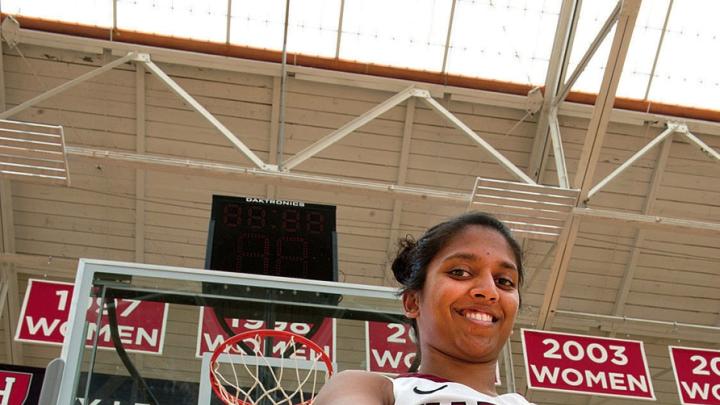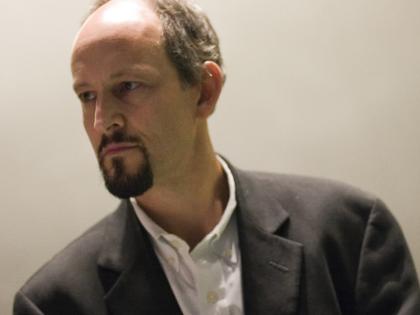In basketball, a three-point play (a three-point shot or a two-point shot, plus a free throw) is an accomplishment. A four-point play (a three-pointer and a free throw) is rare. A five-point play is virtually impossible—but that’s what the Harvard women’s basketball team accomplished last January, and Shilpa Tummala ’16 initiated the action.
The Crimson trailed Dartmouth by 14 points late in the second half, and Harvard needed a comeback to avoid a 0-2 start in conference play to preserve its chance at an Ivy League championship.
Enter Tummala. After scoring a layup to cut the deficit to 12, she held the ball beyond the three-point line with just under six minutes remaining. Temi Fagbenle ’15 set a screen to initiate a pick and roll, but instead of driving to the hoop, Tummala did what she does best: letting it fly from three-point range. The ball went in. Then the whistle blew, and everyone stopped. Dartmouth had fouled Fagbenle, sending the center to the foul line. The three counted, as did the free throws, slicing the deficit to seven.
Tummala wasn’t done. During the next five minutes, she made a steal, a free throw, and then the go-ahead three in Harvard’s 75-69 win. “I was in shock,” she said of her performance and the comeback. “People in the locker room [were] crying because they had never experienced a game so devastatingly weird.” But women’s basketball coach Kathy Delaney-Smith took the performance in stride: “I’m never surprised when Shilpa does that,” she said. “I believe she just loves pressure.”
In fact, Tummala’s scoring itself was deeply surprising. Having suffered severe shoulder injuries during her first two years of college play, her very presence on the court was amazing.
The Crimson guard regards excellent three-point scoring as a byproduct not just of shooting but of complementary skills like dribbling and passing as well. Growing up in Arizona, she modeled her game after the Phoenix Suns’ Steve Nash, an elite point guard who was considered one of the NBA’s most creative passers and an excellent shooter. Tummala is a similar dual threat, capable of taking her shot or driving to the basket and finding open teammates. Several weeks after defeating Dartmouth, for example, when the Crimson trailed Columbia by two points with just under a minute remaining, she again held the ball, but instead of shooting, she went to the hoop, drew the defense, and passed to Erin McDonnell ’15, who hit the game-winning three.
Tummala likes creating scoring opportunities for her teammates, but she also recognizes that passing opens up her own arsenal. “That’s what helps with my scoring abilities,” she said, “because people aren’t necessarily sure if I’m going to attack to create or attack for myself.” Or, as was the case against Dartmouth, attack from three.
The five-foot-eleven player also makes use of her size: she is bigger than most shooting guards in women’s basketball. According to her even taller brother, Sai, a six-foot-six forward on the University of Hawaii men’s basketball team, this enables her to be more “aggressive” and “use her body to get to the basket.” It also means that she can shoot over shorter defenders.
Yet for Tummala, the key to great shooting is repetition. Growing up, she dragged her father, Sekhar, outside daily to work on her shot. They would start with layups and continue to take one step back, build her strength, and hone her form. To this day, her father’s guidance remains influential. “When I’m at the free-throw line, I literally hear his voice,” Tummala explains. “Bend your knees, make sure you bend your knees. Make sure your elbow is in. Make sure it’s at a 90-degree angle. Feet shoulder-width apart.”
This attention to detail and repetition becomes even more important from three-point range (almost six feet further from the basket); given the greater distance and heightened stakes, there is both a smaller margin of error and, as Tummala said, “more pressure to succeed.” Consequently, she focuses intensely on her mechanics, including the details her father emphasized. For every shot, she also squares her body with the basket, and positions the ball in her shooting pocket (a space just to the right of her torso, and above her waist). She jumps straight up and down, releases the ball quickly, and follows through. Executing this technique successfully depends heavily on leg strength, particularly in late-game scenarios when shooters tire, so leg exercises designed to help her jump and explode through her release are part of her regular routine.
She has also trained her mind. She thinks the best three-point shooters—like reigning NBA MVP Steph Curry—benefit from a bad short-term memory (they quickly forget misses), confidence, and above all the ability to get into a rhythm. “I don’t want to sound Confucius-y,” she said, “but you really want to become ‘one’ with the ball.” This doesn’t always happen, she emphasizes, but by practicing visualization exercises and exploring ways to involve her teammates, she thinks less about making the three-point shot and more on finding it and her teammates in the flow of the game.
Having honed her form, strength, and focus, she has the confidence and instincts to launch big shots without forethought—just as she did in Hanover.
As she entered college, many expected Tummala to hit game-changing threes routinely. As a high-school senior, she was one of the top-100 recruits in the country and placed second in a national high-school three-point contest at the 2012 NCAA Final Four. But after suffering season-ending shoulder injuries during her freshman and sophomore years at Harvard, she couldn’t lift a basketball, let alone shoot, with her right hand. The situation was so bleak that her parents broached the possibility of her quitting, but the sharpshooter refused, emphasizing, as her father recalled, that “basketball is a major part of her life.”
Instead she went back to work. In the spring of her sophomore year, when her right arm was in a sling, she began practicing dribbling and shooting left-handed. That summer, she woke up at 4:30 a.m. daily to lift weights and do rehab exercises before going to organic chemistry class and section for at least five hours every weekday. By the fall, she was practicing; halfway through the season, she cemented her place in the starting lineup; and against Dartmouth, she reemerged as an impact player. That second-half stretch was not just the team’s comeback of the season; it was the inflection point in Tummala’s personal recovery.
In part because she missed so much time due to injury, Tummala’s statistics last year—5.8 points and 2.9 rebounds per game—were not gaudy. But the numbers belie her impact: she hit three-pointers in 19 of Harvard’s last 23 games, many of them crucial, including a go-ahead basket against Yale. “She lost almost three years of the transition from high school to Division I college basketball,” Delaney-Smith noted, “and then she still ended up being a starter for us.”
A neurobiology concentrator with a secondary concentration in chemistry, Tummala spent this past summer researching her neuro-oncology thesis, taking the MCAT (she plans to apply to medical school), and working out in Cambridge. She and her brother also traveled to India with Crossover Basketball & Scholars Academy, a nonprofit that uses basketball to create educational opportunities and community change. Reflecting on her undergraduate experience last spring, she said, “The day I stepped on Harvard’s [campus], I was like, ‘Okay, this is who I want to be when I leave this place.’ I’m a junior, and I’m already that person.”
Now, as the start of her senior season approaches, Tummala is as healthy as she has been as a college basketball player and is poised to make an enormous impact on the court. “I couldn’t be more excited about her senior year,” said Delaney-Smith. “I’ve seen wonderful, quiet leadership. I’ve seen a senior emerge with the drive to change things here in our program.”
Tummala is similarly enthusiastic. “I think that Harvard and the basketball team, and the program, has given me literally everything that it possibly could have,” she said. “I’m hoping that at the end of this year I can say that I’ve given a program that’s so wonderful and so amazing, everything that I have to offer.”
She is ready to take her shot.








